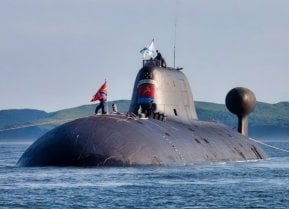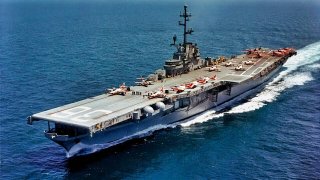USS Antietam: This Navy Aircraft Carrier Proved the Power of the Essex-Class
The USS Antietam Essex-class aircraft carrier was constructed too late to serve in World War II, but the warship participated mightily in the Korean War.
Summary: The USS Antietam, an Essex-class aircraft carrier named after the Civil War Battle of Antietam, served prominently during the Korean War despite being constructed too late for World War II. Part of the largest class of capital ships in the 20th century, the Essex-class carriers were designed after the dissolution of the Washington Naval Treaty, allowing for larger and more heavily armed vessels.
-The Antietam was equipped with advanced damage control, ample fuel capacity, and a robust armament suite, including 5-inch guns and various anti-aircraft weapons. After serving as a patrol vessel post-WWII, the Antietam was reactivated for the Korean War, conducting approximately 6,000 sorties and earning two battle stars for its efforts.
-Post-war, the carrier provided humanitarian aid before being decommissioned and eventually scrapped in 1974.
The Legacy of the USS Antietam: An Essex-Class Carrier at War
The USS Antietam Essex-class aircraft carrier was constructed too late to serve in World War II, but the warship participated mightily in the Korean War.
The carrier was named to honor the American Civil War Battle of Antietam and earned several medals and battle stars during her operational years.
Introducing the Class
The long-hull Essex carriers built before the end of WWII were the largest class of capital ships in the twentieth century. The warships were designed for the U.S. Navy after the overturn of the Washington Naval Treaty. In the 1920s, five powerful maritime nations set out to limit how much tonnage they could build, hoping to slow down an ongoing arms race. The resulting treaty was effective until Imperial Japan withdrew, freeing the rest of the signatories to build larger vessels.
Specs & Capabilities
The initial short-hull Essex-class variants measured over 870 feet long and were more than a third heavier than previous carriers. The Essex had better facilities for handling ammunition, greater fuel capacity, and more advanced damage control equipment than previous carriers. These ships displaced roughly 37,000 tons, and later modified versions were able to displace more than 47,000 tons.
Four Westinghouse geared steam turbines and eight Babcock & Wilcox boilers powered the warships. In terms of armaments, the Essex-class equipped a dozen 5-inch, 38-caliber guns, as well as Bofors 40mm anti-aircraft guns. Oerlikon anti-aircraft guns were equipped on each carrier in this class.
USS Antietam’s Operational History
The Antietam’s keel was laid down in 1943 at the Philadelphia Navy Yard. Within a few years, she launched and was commissioned with Captain James R. Tague in command.
Following her shakedown cruise, the Antietam began the first leg of her transpacific voyage. The vessel sailed to Pearl Harbor in 1945, just a few days before Japan’s capitulation and the subsequent cessation of hostilities. After the war, the Antietam patrolled mostly in the Yellow Sea for three years. She then returned to California, where she remained in reserve until 1950, when North Korea invaded the South.
During the Korean War, the Antietam’s air group flew roughly 6,000 sorties of all variants. She participated in a range of missions during this period, including in support of United Nations forces combating North Korean aggression via anti-submarine patrols and combat air patrols. The Antietam won two battle stars for her service in the Korean War.
In addition to her combat history, the Antietam also provided humanitarian services after Hurricane Carla in Texas and Hurricane Hattie in British Honduras. She remained in reserve at Philadelphia until 1973, when her name was officially struck from the Navy list of active vessels. One year later, the Antietam was sold for scrap.
About the Author: Maya Carlin
Maya Carlin, National Security Writer with The National Interest, is an analyst with the Center for Security Policy and a former Anna Sobol Levy Fellow at IDC Herzliya in Israel. She has by-lines in many publications, including The National Interest, Jerusalem Post, and Times of Israel. You can follow her on Twitter: @MayaCarlin


